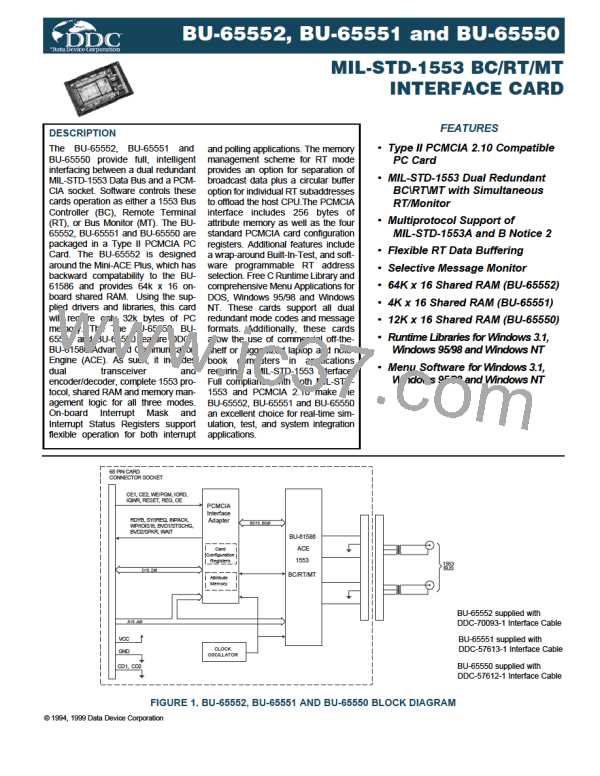prior to the start of the bulk transfer, the BU-65550 and
BU-65551 may be configured to issue an interrupt request only
after it has received the anticipated number of valid Data Words
to the designated subaddress.
most recent valid block of received Data Words will always be
readily accessible to the host processor.As a means of ensuring
data consistency, the host processor is able to reliably access
the most recent valid, received Data Word block by performing
the following sequence:
SUBADDRESS DOUBLE BUFFERING MODE
(1) Disable the double buffering for the respective subad-
dress by the Subaddress Control Word. That is, temporarily
switch the subaddresses' memory management scheme to
the Single Message mode.
For receive (and broadcast) subaddresses, the BU-65552, BU-
65551 and BU-65550 RT offer a third memory management
option, Subaddress Double Buffering. Subaddress double
buffering provides a means of ensuring data consistency.
FIGURE 12 illustrates the RT Subaddress Double Buffering
scheme. Like the Single Message and Circular Buffer modes,
the Double Buffering mode may be selected on a subaddress
basis by means of the Subaddress Control Word. The purpose
of the Double Buffering mode is to provide the host processor a
convenient means of accessing the most recent, valid data
received to a given subaddress. This serves to ensure the high-
est possible degree of data consistency by allocating two 32-bit
Data Word blocks for each individual receive (and/or broadcast)
subaddress.
(2) Read the current value of the receive (or broadcast) sub-
address's Lookup Table pointer. This points to the current
"active" Data Word block. By inverting bit 5 of this pointer
value, it is possible to locate the start of the "inactive" Data
Word block. This block will contain the Data Words received
during the most recent valid message to the subaddress.
(3) Read out the words from the "inactive" (most recent) Data
Word Block.
(4) Re-enable the Double Buffering mode for the respective
subaddress by the Subaddress Control Word.
At a given point in time, one of the two blocks will be designated
as the "active" 1553 data block while the other will be designat-
ed as the "inactive" block. The Data Words from the next receive
message to that subaddress will be stored in the "active" block.
Upon completion of the message, provided that the message
was valid and Subaddress Double Buffering is enabled, the BU-
65552, BU-65551 and BU-65550 will automatically switch the
"active" and "inactive" blocks for the respective subaddress. The
ACE accomplishes this by toggling bit 5 of the subaddresses'
Lookup Table Pointer and rewriting the pointer. As a result, the
RT INTERRUPTS
As in BC mode, the BU-65552, BU-65551 and BU-65550 RT
provide many maskable interrupts. RT interrupt conditions
include End of (every) Message, Message Error, Selected
Subaddress (Subaddress Control Word) Interrupt, Circular
Buffer Rollover, Selected Mode Code Interrupt, and Stack
Rollover.
CONFIGURATION
REGISTER
STACK
POINTERS
DESCRIPTOR
STACK
LOOK-UP
TABLES
15
13
0
DATA
BLOCKS
CURRENT
AREA B/A
BLOCK STATUS WORD
TIME TAG WORD
X..X 0 YYYYY
DATA
BLOCK 0
DATA BLOCK POINTER
DATA BLOCK POINTER
X..X 1 YYYYY
RECEIVED COMMAND
WORD
DATA
BLOCK 1
RECEIVE DOUBLE
BUFFER ENABLE
MSB
SUBADDRESS
CONTROL WORD
FIGURE 12. RT MEMORY MANAGEMENT: SUBADDRESS DOUBLE BUFFERING MODE
21

 ETC [ ETC ]
ETC [ ETC ]